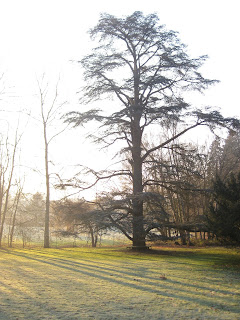Starting Get Outside in Lent made me think about how the natural world has intertwined with my life. Considering the different categories - trees, water, flowers, birds - immediately brought up memories of particular plants, animals and rivers.
Writing about this feels a little like escapism - conjuring up birds in clear skies and summer afternoons in a canoe, instead of dealing with destruction and desolation. But being connected to nature is what makes us human too. We cannot reduce the rest of the world to an exploited resource, or a mere backdrop to our fights and squabbles. We are part of the earth, and the earth is part of us.
So, trees.
 |
| Image © Yeldall Manor. Used with permission. |
Like many children, my early encounters with trees involved climbing them. I remember a particular cherry tree on a piece of rough ground next to our house. An old lawn chair provided the boost up to its lowest branch, which was worn smooth and shiny from all the fingers which had swung from it. From there you could climb up the next few branches, ladder-like, and perch contentedly among the leaves.
Once my friend Katy and I were camping out in my back garden, and she wanted to climb the cherry tree in the dead of night. I chickened out of that one. I crept into her tent and turned the alarm clock off, and she never knew why it didn't wake her up.
A few years later we moved to Yeldall Manor, where there were more trees than you could shake a stick (ahem) at. I cycled to school between the giant redwoods which stood sentry down the main drive, made dens underneath the spreading branches of rhododendron bushes, and went wandering in the seemingly endless woods "up the hill".
A huge cedar tree on the back lawn had a swing on it, with a broad wooden seat and long ropes. I'd sit sideways on it, pushing my toes against the craggy trunk to keep myself rocking gently back and forth. Or I'd twist it round and round, winding the ropes together until the seat was high off the ground and the swing twanged with potential energy. I'd jump on quick and whirl dizzily, down and down until the ropes were free, a breath of a pause, and then up again as they twisted together the other way, until finally the swing came to rest.
The tree is still there. The swing isn't.
 |
| Image © Yeldall Manor. Used with permission. |
Near my halls of residence at university I discovered Bishops Knoll Wood, which became a favourite place to sit and think. It had once been a garden of a big house, but now felt overgrown and forgotten. Some gnarled apple trees grew among nettles - the remains of an orchard - and dropped their fruit for the wasps to enjoy. Further in, a stone wall formed a terrace in the hillside, and the land dropped off steeply to the River Avon, so that you could sit on the wall and look over the tops of the trees lower down. The wood was popular with dog walkers, of course, but it was never busy. I once met a lady walking ferrets on a lead there.
Later in life, when Graham, Toby and I moved to Derby in the depths of a miserable and icy winter, our cramped rented house had this one redeeming feature: it was the only house I've lived in with a flowering cherry in the garden. Come spring, it burst into extravagant explosions of pink blossom, restoring a little joy to our lives.
 |
| Image credit: Pixabay |
Our current bedroom window has a view of a gigantic plane tree. The mottled trunk reaches twice the height of the surrounding houses. Next to it is a pine tree, almost as tall but not as wide. We admire them from a safe distance, feeling secretly glad that it's not our house they risk falling on.
The horse chestnut round the corner, though, is a familiar tree - we watch its progress every year from sticky buds to white flowers and umbrellas of leaves, and then to tiny spiky green balls. These swell up and fall before we know it, and the boys eagerly jump on them, pouncing on the treasure within - one polished brown nut, or two or three snuggled together in one shell, their smooth sides perfectly matched.
 |
| Image credit: Pixabay |
One thing I've never actually done is plant a tree. Maybe I should change that.
Comments